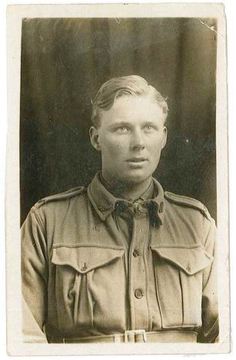Pte
William Pegler
Information about birth
|
Year of birth: 1895 |
|
Place of birth: Uxbridge, New Norfolk, Tasmania, Australia |
General information
|
Last known residence: Uxbridge, New Norfolk, Tasmania, Australia |
|
Profession: Farmer |
|
Religion: Roman Catholic |
Army information
|
Country: Australia |
|
Force: Australian Imperial Force |
|
Rank: Private |
|
Service number: 2865 |
|
Enlistment date: 20/05/1916 |
|
Enlistment place: Claremont, Tasmania, Australia |
|
Units: — Australian Infantry, 40th Bn. (Last known unit) |
Information about death
|
Date of death: 04/10/1917 |
|
Place of death: Beecham Dugout, Zonnebeke, Belgium |
|
Cause of death: Killed in action (K.I.A.) |
|
Age: 22 |
Memorial
|
Ypres (Menin Gate) Memorial Panel: 25G |
Distinctions and medals 2
|
British War Medal Medal — 20/05/1921 |
|
Victory Medal Medal — 20/05/1921 |
Points of interest 4
| #1 | Place of birth | ||
| #2 | Last known residence | ||
| #3 | Enlistment place | ||
| #4 | Place of death (approximate) |
My story
William Pegler was the son of Charles and Margaret Kate Pegler. He was born around 1895 in Uxbridge, New Norfolk, Tasmania. He worked as a farmer. In May 1916, he enlisted in the Australian Army at Claremont. William belonged to the 40th Battalion (10th Brigade, 3rd Division).
William was killed on 4 October 1917 at the Battle of Broodeinde, part of the Battle of Passchendaele. The 10th Brigade started the attack near Van Isackere Farm near Zonnebeek. The wet ground made it difficult to take up positions. The plan of attack was as follows: the 37th, 38th and 39th would each move forward and take an objective. They would so advance to the third objective, which was the line that started near Berlin Wood and ran through Beecham to the area around Marne. Then the 40th Battalion would take over the attack and advance as far as the Keerselarehoek. In doing so, they would take the line that started near Augustus Wood and ran through Hamburg to Tyne Cot. As the advance progressed, the ground became boggier and wetter. Moreover, German shelling caused many casualties. The 40th Battalion was shelled from Hamburg and Dab Trenches, among others, but they managed to eliminate those posts. They reached their objective, the Keerselarehoek, after which they started to dig in. However, consolidation of the captured areas was hampered by shelling from German machine guns and snipers. The dispatched troops managed to eliminate those posts as well. German attempts to launch a counterattack were repelled.
According to testimonies, William was hit by a shell during this attack. However, his body was not recovered or identified. William is commemorated at the Menin Gate.
William was killed on 4 October 1917 at the Battle of Broodeinde, part of the Battle of Passchendaele. The 10th Brigade started the attack near Van Isackere Farm near Zonnebeek. The wet ground made it difficult to take up positions. The plan of attack was as follows: the 37th, 38th and 39th would each move forward and take an objective. They would so advance to the third objective, which was the line that started near Berlin Wood and ran through Beecham to the area around Marne. Then the 40th Battalion would take over the attack and advance as far as the Keerselarehoek. In doing so, they would take the line that started near Augustus Wood and ran through Hamburg to Tyne Cot. As the advance progressed, the ground became boggier and wetter. Moreover, German shelling caused many casualties. The 40th Battalion was shelled from Hamburg and Dab Trenches, among others, but they managed to eliminate those posts. They reached their objective, the Keerselarehoek, after which they started to dig in. However, consolidation of the captured areas was hampered by shelling from German machine guns and snipers. The dispatched troops managed to eliminate those posts as well. German attempts to launch a counterattack were repelled.
According to testimonies, William was hit by a shell during this attack. However, his body was not recovered or identified. William is commemorated at the Menin Gate.
Sources 5
|
10th Australian Infantry Brigade, (Australian War Memorial, Campbell (AWM), AWM4 23/10/12). https://www.awm.gov.au/ Sources used |
|
40th Australian Infantry Battalion, (Australian War Memorial, Campbell (AWM), AWM4 23/57/13). https://www.awm.gov.au/ Sources used |
|
Australian Red Cross Wounded and Missing Enquiry Bureau (Australian War Memorial, Campbell (AWM), RCDIG1064166). https://www.awm.gov.au/ Sources used |
|
First Australian Imperial Force Personnel Dossiers, 1914-1920 (National Archives of Australia, Canberra (NAA), B2455, PEGLER W.). https://recordsearch.naa.gov.au/ Sources used |
|
McCarthy, Chris. Passchendaele: the Day-by-Day Account. (Londen: Unicorn Publishing Group, 2018), 110-113. Sources used |
More information 4
|
Commonwealth War Graves Commission Database https://www.cwgc.org/find-records/find-war-dead/casualty-details/1600297 |
|
Namenlijst (In Flanders Fields Museum) https://namenlijst.org/publicsearch/#/person/_id=d5bf47f0-8420-4ad0-9ac6-07accf996e2b |
|
Lives of the First World War (Imperial War Museum) https://livesofthefirstworldwar.iwm.org.uk/lifestory/7543436 |
|
The AIF Project (UNSW Canberra) https://aif.adfa.edu.au/showPerson?pid=237716 |
